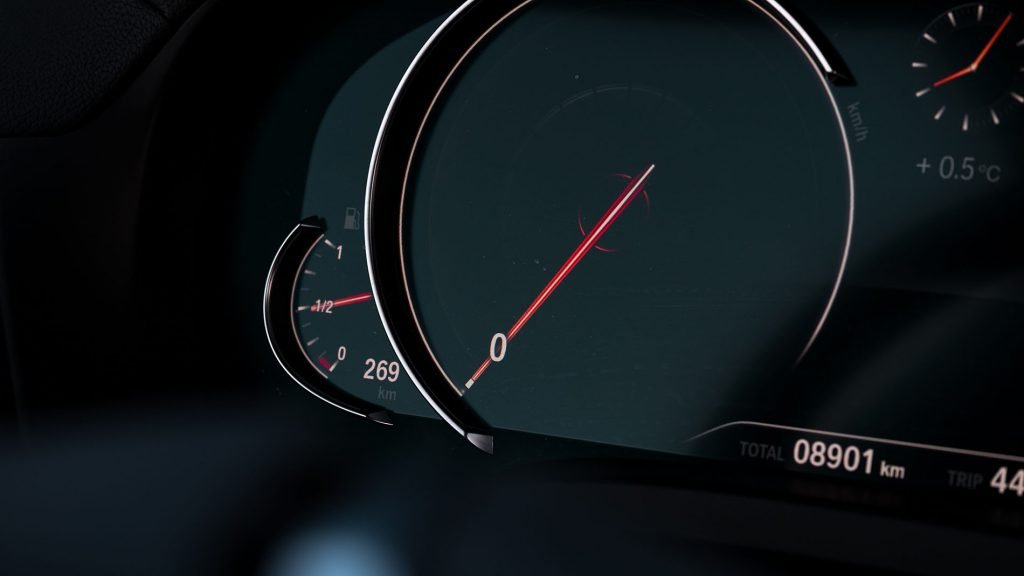
Thinking about new wheels for your car or truck? Aftermarket wheels are a great way to individualize your ride. Upsizing or switching to a staggered fitment can completely change the look of a car or truck. When someone is changing the size of their wheel, they often ask: “Does changing the wheel size affect the speedometer?”. The answer is Yes, but it doesn’t have to. Let me explain.
HOW YOUR SPEEDOMETER WORKS
The speedometer was calibrated at the factory for the stock size tires and wheels that would be installed before the vehicle left the line.
The calibration was calculated based on the ratios of the gears in the drive cable, the final drive ratio in the differential, and the diameter of the tires.
That last item is crucial. See for every revolution of the tire, the wheel covers a certain distance. The distance that tire covers in one spin is equal to its circumference. Quick geometry refresher:
circumference = diameter x π (in case you forgot pi = 3.14159)

A 20″ wheel will cover 62.83 inches (give or take a few more decimal spaces) in one spin. Replace those with 24″ wheels and now you’re covering 75.40 inches, but your speedometer won’t know the difference. So, you see how changing wheel size affects the speedometer? But it doesn’t have to happen. Just stick to the original combined diameter of the wheel and tire and you should be good. Here’s how.
CHANGING WHEEL SIZE WITHOUT AFFECTING SPEEDOMETER
For a practical example, let’s say you are lucky enough to own a 2018 Lexus GS350. When you can manage to pull the ladies off you and your car long enough to get online, you start shopping for some new badass wheels. You’ve got the stock 17″ wheels on there now and you want more.
So, you look at 18″ inch wheels and you are obsessed with the Niche M192 Altair Matte Black. The bolt pattern, backspacing, and offset are a perfect match. You love the way those spokes extend to the rim and the black contrasts are the bomb. But what’s going to happen to your speedometer if you go up to 18″ wheels? Will you attract as many cops as chicks because you can’t gauge your speed? At 17″, each revolution is covering 53.41 inches of road. At 18 you’re up to 56.55 inches. That’s almost 6% more with only one revolution.
Here’s what you do so that changing the wheel size won’t affect the speedometer. You’re going to change the standing height of the tire. In other words, since you added an inch to the wheel, you can subtract an inch from the standing height of the tire. With a softer sidewall, you may even find that Lexus even handles better.
But what if you want to go even bigger and more badass? Maybe you decide to kick on the afterburners with something from the Flow Formed Varro Wheels. Maybe something like the Varro VD38X Gloss Black in 20″. Screw the lip, let’s go for an awesome sporty style and a hellah wicked spoke design like no other. Now you’re talking. But are those extra 3 inches going to ensure that you’re always speeding? Instead of 53.41 inches you’re covering 62.83 inches or almost 15% more! Nope, you aren’t going to let that extra size bother you. That’s because you are going to make sure that changing the wheel size doesn’t change the speedometer. You’re going to wrap those bad boys in a set of low aspect tires.
The aspect is the second number in a tire size. For example, you score the Ironman iMove Gen2 all season tire in a 225/35/20 size because you don’t need winter tires where you live and you aren’t going off-roading in your GS350. You’re safe with this tire because the first number is the tire width in millimeters and the last number is the diameter in inches. That middle number is the ratio of the sidewall to the tire width. And, 35 isn’t large. Chances are, you are riding on 50s or 45s right now. The smaller the number, the lower the profile. Don’t ask why the width is measured in millimeters and the diameter is measured in inches. Don’t go there. Just know that as the diameter of the wheel goes up, you are going to decrease the standing size of the tire by the same amount and go for a low aspect tire.
PLUS 1, PLUS 2, HUT HUT
So, when you hear gearheads talking “plus 1, plus 2, or plus 3” they aren’t getting ready to snap a football. They’re using shorthand to refer to the process I just described above in detail. Plus 1 means that they’ve taken a stock wheel and tire combination and increased the wheel size 1 inch. When they say “plus 2” the wheel size has gone up 2 inches and the tire profile has been decreased accordingly. Same thing for plus 3. It’s how you go about changing wheel size without messing up the speedometer.
And you really don’t want to ever go more than plus 3 without serious modifications. The added mass of the larger tires will wreak havoc with your fuel efficiency, and you don’t want problems with your suspension. There are other rules of thumb (like the % rule) for upsizing, but they require you to convert inches to millimeters and do you really want to do all that math? There’s an easier way to know for sure.
JUST ASK IF THE NEW WHEEL SIZE AFFECTS SPEEDOMETER
If you don’t want to stress about all the math and geometry and stuff and just want to focus on getting the biggest, baddest wheels that won’t mess with your ABS or speedometer, just ask the pros at Powerhouse Wheels.
Seriously, it’s just that easy. Call 813-591-0551. Tell them about your ride and the wheels you want. Their fitment program won’t steer you wrong.



